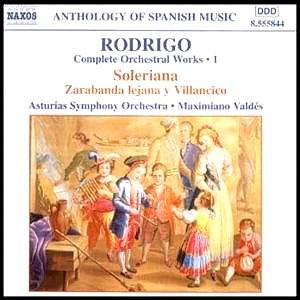What is one to make of Joaquín Rodrigo? Everyone
knows the Concierto de Aranjuez and the Fantasia para un gentilhombre
and thatís it. Naxos has embarked bravely on the complete orchestral
works with a recording by the Asturias orchestra of three suites, all
of tuneful and short dance movements. The Zarabanda lejana y Villanico
is a two movement suite, a dreamy sarabande followed by a lively and
very pretty rondo. Both pieces were originally for guitar and were arranged
for string orchestra in 1930. The Asturias strings sound a touch scrawny
here, but throughout the rest of the programme they show themselves
a very respectable band. Prospective purchasers need not worry on this
score.
The second short suite is the Cinco Piezas Infantiles
(Five Childrenís Pieces). This is much more interesting musically and
I found it significant that, as the notes revealed, this was the period
when he made contact with "a group of avant-garde composers in
Madrid." For these are really very imaginative and, as noted at
the time, "curious", pieces. Rodrigo shows here what he might
have become had he not failed to make an impression on the judges of
the national music prize in 1925 and moved to Paris. All the movements
are good but particularly impressive is Después de un cuento
where for just over three minutes Rodrigo creates a truly magical sound
picture quite unlike the popular works noted above. The bulk of the
disc is taken up with Soleriana an eight movement suite derived
from sonatas by the remarkable Padre Antonio Soler (whose music so enthralled
me in another recent Naxos release 8.555031). Soleriana is the
sort of thing Respighi did so well in The Birds and the suites
of Ancient Airs and Dances. Sadly I have to report that beyond
being very easy to listen to, Rodrigoís efforts seem to miss the bite
and originality of his compatriot Solerís brilliant compositions and
he just doesnít orchestrate as imaginatively as Respighi. Soleriana
is charming and tuneful indeed, but unlikely to make one return to this
disc.
I regret that on the strength of this, Naxos have done
nothing to answer my question at the start. However did Rodrigo manage
to write one of the best tunes of the 20th century, the slow
movement of the Concierto de Aranjuez, within one of two brilliant
and justifiably popular guitar concertos, and yet produce apparently
nothing else of note? The liner notes are a mixture of interesting history
and oddly incomprehensible commentary for which I am uncertain whether
to blame the author or the translator. The cover picture is called Christmas
Nights and is absolutely nothing to do with the music so perhaps
the producers had the same trouble as me getting excited about this
issue. An excellent website exists at http://www.joaquin-rodrigo.com/indexfen.html
and I would urge the Rodrigo enthusiast to visit it.
Dave Billinge


